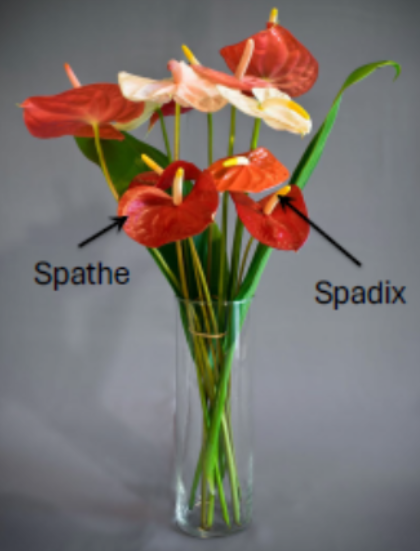Module 1: Flowering and Seeds
1/19
There's no tags or description
Looks like no tags are added yet.
Name | Mastery | Learn | Test | Matching | Spaced |
|---|
No study sessions yet.
20 Terms
Cut flowers have a limited shelf (vase) life as reserves of moisture and carbohydrates present at the time of harvest decline over time
This results in:
Wilting
Flower and foliage deterioration
Leaf and flower abscission
Flower senescence
Programmed cell death
How does respiration result in physiological changes in cut flowers
Respiration is the oxidative breakdown of complex substrates (starch, sugars, organic acids) to simpler molecules (CO2 and H2O) for production of energy and intermediate molecules such as ATP.
This results in a loss of substrates, requirement for oxygen, production of heat and CO2
How does transpiration result in physiological changes in cut flowers
Transpiration is water movement through plant stems with evaporation through stomata and some petals
Stomata open to allow uptake of CO2
How does ethylene production and sensitivity result in physiological changes in cut flowers
Involved in several phases of flowering from bud induction through to growth of floral tissues, petal senescence and flower abscission
How does maintenance of cell membranes result in physiological changes in cut flowers
Cell turgor, osmotic potential
Practical measures to prolong shelf life
Supplemental reserves of carbohydrates
Supplying sugars in vase water
Reducing loss of water
Cooling and storage at high humidity
Reducing leaf area
Packaging
Slowing cell metabolism
Cooling and storage in low light or darkness
Reducing contaminants
Treating with antifungal and antibacterial solutions or sprays
Placing stems into acidic water
Promoting/increasing water uptake
Placing stems into water as soon as possible after harvest
Cutting stem at 45 degree angle
Removing stem embolism (‘bubbles’) or other blockages by cutting stem underwater
Change water in vase regularly
Chemical methods to prolong shelf life
Distilled water (DW)
Sucrose thiosulfate solution (Suc) → as a source of energy
8-Hydroxy quinoline sulphate (HQS) → acts of ethylene receptors and production sites
Kinetin (Kin) → plant hormone that slows processes associated with both senescence and stress

E.g. shelf-life of cut flowers of anthurium
Shelf-life of 15-49 days
Shelf-life determined by browning of peduncle base; spathe floppiness, discolouration and loss of lustre and necrosis of spathe and spadix
Predictors of anthurium shelf-life
High abaxial stomatal density related to short shelf-life
Increased transpiration and water loss
Spathe colour green related to long shelf-life
Due to presence or absence of chlorophyll
On-going photosynthesis and continued carbohydrate supply
Spathe colour white related to long shelf-life
Due to presence or absence of flavones (white pigments) which have a strong antioxidant capacity
Large spathe (surface area and thickness) related to short-life
Increased loss of water (transpiration) from tissues
Thick cuticle on spathe related to long shelf-life
Reduced loss of water (transpiration) from tissues
Stages of flowers after being cut
Stage 1: small green bud
Stage 2: bud at full colour, ready to open
Stage 3: half open flower
Stage 4: fully opened flower
Stage 5: wilted flower
How do soluble sugars, soluble proteins and malondialdehyde change over time of development
Soluble sugars decrease over development
They are an energy source, a structural constituent of cells, and act as signals to regulate processes associated with plant growth and development
Soluble proteins decrease with development
They provide nutrition to buds and developing flowers and are involved in transport, structural support, and ion regulation during flowering
Malondialdehyde increase with development
This is an indicator of oxidative stress
Electrolytic leakage increase with development
is an indicator of breakdown of cell membranes
Effect of plant hormones
Ethylene
is a plant hormone (phytohormone) produced by all plants
influences growth and development of plants throughout their life cycle
is active at very low concentrations
Cut flowers with sensitivity: Astroemeria, Asiatic Lily, Oriental Lily, Carnation, Lisianthus, Daffodil, Freesia, Stock
External supply of ethylene
For some species causes wilting, petal and flower abscission, flower fail to open and senescence of open flowers
For other species there is little or no effect
Internal formation of ethylene
Triggers ripening and senescence of flowers and fruits
Activation of bulbs
Produced when plants are wounded
Why is Saffron so valuable
Each flower produces three stigmas/styles
150,000-250,000 flowers required to produce 1 kg of saffron
Stigmas only harvested mid-morning when the flowers are fully opened
Reproduction biology of Saffron
Long history of cultivation so it no longer grows in the wild
Male flowers are sterile due to inability to pair chromosomes during meiosis
Flowers are self-incompatible so fail to produce viable seeds
Unique climatic conditions are need to grow Saffron
Biochemistry of Saffron
Crocin is responsible for the distinctive colour of saffron
Safranal creates the aroma of saffron
Picrocrocin imparts the flavour (grassy or hay-like) of saffron
What is phenology
A natural cyclic and seasonal phenomena
e.g. leaf emergence, leaf fall, flowering and fruiting, seed germination
Environmental factors in timing of flowering
Floral evocation: the conditions required for an apical meristem to become a flower
Environmental cues includes:
Photo period (day length)
Temperature
Competition from other plants
Nutrient availability
Interactions with animals
Internal cues include:
Plant age
Plant size
Hormonal signals
How does photoperiod affect timing of flowering
Short-day plants flower when an uninterrupted period of darkness exceeds a critical night length
Long-day plants flower when a period of darkness is less than critical night length
How does vernalisation affect timing of flowering
Vernalisation is prolonged cold temperature
Ensures that reproductive development and seed production occurs in winter or spring, rather then in autumn
Flowering is promoted with cold periods; effective range between freezing and 10 degrees, optimum range between 1-7 degrees
Plant in warm climates
Other environmental cues are more important
E.g. fire-induced flowering
Phenology and climate change
Increased temperature and more unpredictable weather events will impact flowering